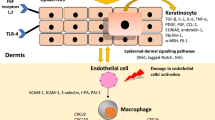Abstract
Localized scleroderma (LSc), a connective tissue disorder restricted to the skin and subcutaneous tissue, is characterized by skin fibrosis due to an excessive deposition of types I collagen. The mechanism of such fibrosis is still unknown, but epigenetics may play some roles in the excessive collagen expression. In the present study, we investigated the mechanism of fibrosis seen in LSc, focusing on microRNA (miRNA). miRNA expression was determined by PCR array, real-time PCR, and in situ hybridization. The function of miRNA was evaluated using specific inhibitor. Immunoblotting was performed to detect α2(I) collagen protein. PCR array analysis using tissue miRNA demonstrated miR-7 level was significantly decreased in LSc skin as well as keloid tissue compared to normal skin in vivo. In situ hybridization also showed miR-7 expression in dermal fibroblasts was decreased in LSc dermis. The transfection of specific inhibitor for miR-7 into cultured normal dermal fibroblasts resulted in the up-regulation of α2(I) collagen protein in vitro. Also, the serum levels of miR-7 were significantly decreased in LSc patients compared with healthy controls, but serum miR-29a levels not. Systemic or local down-regulation of miR-7 may contribute to the pathogenesis of LSc via the overexpression of α2(I) collagen, and serum miR-7 may be useful as a disease marker. Investigation of the regulatory mechanisms of LSc by miRNA may lead to new treatments by the transfection into the lesional skin of this disease.




Similar content being viewed by others
References
Arkachaisri T, Vilaiyuk S, Li S et al (2009) The localized scleroderma skin severity index and physician global assessment of disease activity: a work in progress toward development of localized scleroderma outcome measures. J Rheumatol 36:2819–2829
Arkachaisri T, Vilaiyuk S, Torok KS, Medsger TA (2010) Development and initial validation of the localized scleroderma skin damage index and physician global assessment of disease damage: a proof-of-concept study. Rheumatology (Oxford) 49:373–381
Asano Y, Ihn H, Jinnin M, Mimura Y, Tamaki K (2006) Involvement of αvβ5 integrin in the establishment of autocrine TGF-β signaling in dermal fibroblasts derived from localized scleroderma. J Invest Dermatol 126:1761–1769
Chen H, Shalom-Feuerstein R, Riley J et al (2010) miR-7 and miR-214 are specifically expressed during neuroblastoma differentiation, cortical development and embryonic stem cells differentiation, and control neurite outgrowth in vitro. Biochem Biophys Res Commun 394:921–927
Cohly HP, Scott H, Ndebele K, Jenkins JK, Angel MF (2002) Differential gene expression of fibroblasts: keloid versus normal. Int J Mol Sci 3:1162–1176
Falanga V, Medsger TJ, Reichlin M (1985) Anti-nuclear and anti-single-stranded DNA in linear scleroderma. Arch Dermatol 123:350–353
Furer V, Greenberg JD, Attur M, Abramson SB, Pillinger MH (2010) The role of microRNA in rheumatoid arthritis and other autoimmune diseases. Clin Immunol 136:1–15
Ihn H, Sato S, Fujimoto M, Kikuchi K, Takehara K (1996) Clinical significance of serum levels of soluble interleukin-2 receptor in patients with localized scleroderma. Br J Dermatol 134:843–847
Jiang L, Liu X, Chen Z et al (2010) MicroRNA-7 targets IGF1R (insulin-like growth factor 1 receptor) in tongue squamous cell carcinoma cells. Biochem J 432:199–205
Kanemaru H, Fukushima S, Yamashita J et al (2011) The circulating microRNA-221 level in patients with malignant melanoma as a new tumor marker. J Dermatol Sci 61:187–193
Kubo M, Ihn H, Yamane K, Tamaki K (2001) Up-regulated expression of transforming growth factor β receptors in dermal fibroblasts in skin sections from patients with localized scleroderma. Arthritis Rheum 44:731–734
Li J, Zhang Y, Kuruba R et al (2011) Roles of microRNA-29a in the antifibrotic effect of farnesoid X receptor in hepatic stellate cells. Mol Pharmacol 80:191–200
Long JM, Lahiri DK (2011) MicroRNA-101 downregulates Alzheimer’s amyloid-β precursor protein levels in human cell cultures and is differentially expressed. Biochem Biophys Res Commun 404:889–895
Makino T, Jinnin M, Muchemwa FC et al (2010) Basic fibroblast growth factor stimulates the proliferation of human dermal fibroblasts via the ERK1/2 and JNK pathways. Br J Dermatol 162:717–723
Maurer B, Stanczyk J, Jüngel A et al (2010) MicroRNA-29, a key regulator of collagen expression in systemic sclerosis. Arthritis Rheum 62:1733–1743
Pandit KV, Milosevic J, Kaminski N (2011) MicroRNAs in idiopathic pulmonary fibrosis. Transl Res 157:191–199
Sato S, Ihn H, Soma Y et al (1993) Antihistone antibodies in patients with localized scleroderma. Arthritis Rheum 36:1137–1141
Sato S, Fujimoto M, Ihn H, Kikuchi K, Takehara K (1994) Clinical characteristics associated with antihistone antibodies in patients with localized scleroderma. J Am Acad Dermatol 31:567–571
Takehara K, Kikuchi K, Soma Y, Igarashi A, Ishibashi Y (1990) Anti-single-stranded DNA antibody and muscle involvement in localized scleroderma. Arch Dermatol 126:1368
Uziel Y, Krafchik B, Feldman B, Silverman E, Rubin L, Laxer R (1994) Serum levels of soluble interleukin-2 receptor. A marker of disease activity in localized scleroderma. Arthritis Rheum 37:898–901
Acknowledgments
We thank Ms. Junko Suzuki and Ms. Chiemi Shiotsu for their valuable technical assistance. This study was supported in part by a grant for scientific research from the Japanese Ministry of Education, Science, Sports and Culture, by project research on intractable diseases from the Japanese Ministry of Health, Labour and Welfare, and by Shiseido Research Grant.
Author information
Authors and Affiliations
Corresponding author
Rights and permissions
About this article
Cite this article
Etoh, M., Jinnin, M., Makino, K. et al. microRNA-7 down-regulation mediates excessive collagen expression in localized scleroderma. Arch Dermatol Res 305, 9–15 (2013). https://doi.org/10.1007/s00403-012-1287-4
Received:
Revised:
Accepted:
Published:
Issue Date:
DOI: https://doi.org/10.1007/s00403-012-1287-4




